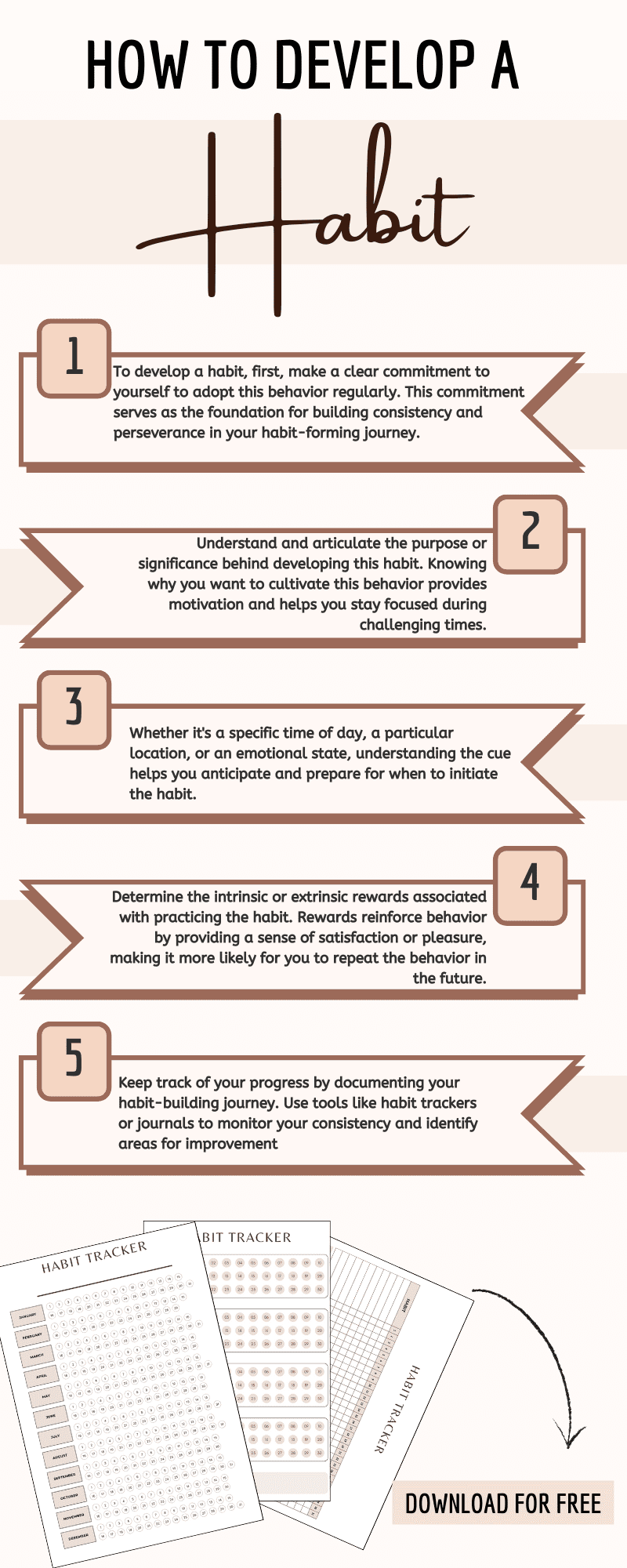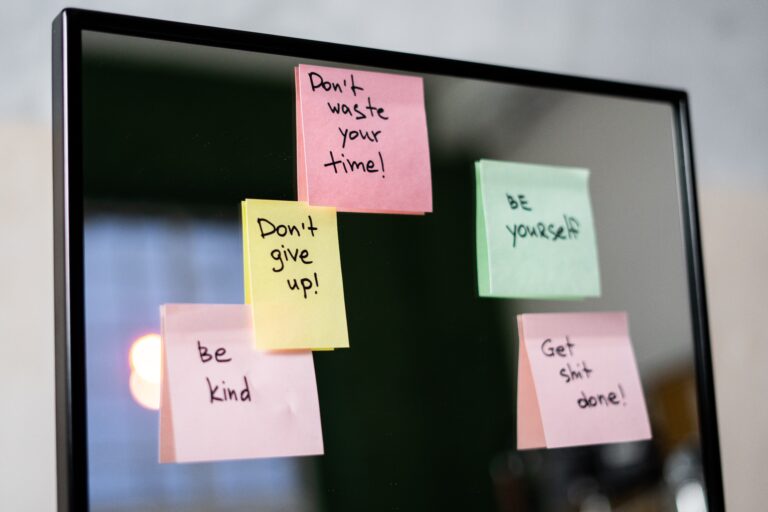Guide On How To Easily Habit Track + Free Printable
Building new habits can be a challenging battle, yet it is incredibly important for our personal development and improving our quality of life. Developing a habit such as playing games or watching television at a certain time may not require much effort, but what about tasks like vacuuming the house or ironing clothes? Surely, these are not activities that everyone enjoys and finds relaxing. Consistency is key in forming habits, and to achieve this, an effective tool is a habit tracker. Let’s explore ways to track habits and tips on how to habit track.
We often hear the phrase ‘New year, new me’ at the beginning of a new year or at the start of any new period. However, we quickly find ourselves trapped in patterns that lead us back to old habits we tried to overcome.
What is a habit tracker and how does it work?
A habit tracker is a tool used to monitor our activities and habits that we want to incorporate into our lifestyle. The simplest technique is using a calendar, where we mark each habit daily. If you want to meditate daily, choose a symbol (such as a tick) and draw it on the calendar every time you successfully do it. Simple, isn’t it? Towards the end of the month, you can review how consistent you were and what you expected from yourself the following month.
Each habit requires time and repetition. Look at your morning routine; most of us visit the restroom, and then each begins our day differently. Some rush to brush their teeth, while others who have pets like dogs take them out first. Every habit we perform daily has been repeated a certain number of times. A study conducted at University College London found that it takes an average of 66 days to establish ingrained new habits. However, since I mentioned the average, we must consider that this time varies from person to person.
Habit trackers usually include a simple system for recording and tracking habits, either in the form of manually kept journals or applications on devices. It’s not necessary to just record if we’ve done the new habit; it can also include tracking time (when exactly we did the new habit), how long we did it, and if we were effective and satisfied. In addition, habit trackers can serve as motivational tools, as they encourage consistency and perseverance in our efforts.

What are the benefits of tracking habits?
John Dryden said, ‘We first make our habits, and then our habits make us.’ Our actions and decisions determine our path. Ask yourself: WHERE DO YOU SEE YOURSELF IN 5 YEARS? And now, think carefully about what you’re doing to actually be there in 5 years. Do you want to progress in your career? Okay, let’s rely on another question: Do your habits and behaviors indicate that you will truly be at that point in your career in 5 years? You know, nothing ventured, nothing gained.
So, it’s very important what we do today. So far, we’ve only talked about creating new habits, but we all also have habits that we’re not proud of and that bring us no benefits. We can also track bad habits, but in a way that records avoiding these habits. Therefore, tracking habits spares us many benefits, such as better quality of life, increased productivity, goal achievement, improved health and well-being, and fostering self-discipline.
Examples of habits you can track
- Morning 5-minute stretching
- 10 minutes of meditation
- Wake up at 5 a.m.
- 1-hour fitness workout
- Taking supplements
- Doing the dishes
- Nature walk
- Drinking enough water
- Sugar-free day
- Making the bed in the morning
- Waste management
- Watering plants
- Walking the dog
- Alcohol-free day
- Smoke-free day
- Reading 3 pages of a book.
In the book “Atomic Habits,” James Clear emphasizes the importance of understanding and changing our habits to achieve desired goals. The book recommends using the 2-minute rule, which it suggests reducing habits until they take two minutes to perform. So start with new habits that are shorter than two minutes, such as waste management, making the bed in the morning, and so on. Later, expand your list and also the duration of the habits.
Tips on how to start tracking new habits
1. Decide how you will track new habits
Before deciding to start tracking new habits, the first step is choosing a method to record and monitor your progress. Among the most popular methods are physically writing in a notebook or using an application. Both methods have their advantages, so it’s important to decide which one is best for you.
Pen and notebook
Physically writing has a charm that no digital technology can provide. Just as pen and paper are intimate tools for expressing thoughts, a habit-tracking notebook can be an excellent tool for tracking new habits. The advantages of physical writing include the following:
- Physical writing allows for a better connection between our thoughts and the activities we record. This allows us to delve into the process and reflect on our actions.
- While physically writing, there is less chance of experiencing distractions, such as notifications or reminders, that could divert us from our goal. Therefore, physical writing enables better focus and concentration.
- Tracking and recording on paper gives us a sense of achievement and satisfaction. Seeing our habits written on paper can be incredibly motivational and encouraging.
Using applications
Since most of us cannot imagine a day without technology, applications have become a popular tool for tracking new habits. Due to their ease of use and various functions. Advantages include:
- Applications offer various features and customization options, allowing us to create a customized habit tracker. Additionally, applications are usually very easy to use, making habit tracking easier even for those not accustomed to keeping a journal.
- Applications allow us to carry our tracking record with us on smartphones. Additionally, our data can be synchronized to the cloud, allowing us to access it on multiple devices.
- Many applications have reminder features that remind us to perform a certain habit at a specific time or place. This helps us maintain consistency and discipline
Techniques For Time Management And Better Planning Of The Day
2. Set smart goals
S – Specific
M – Measurable
A – Achievable
R – Relevant
T – Time-bound
This will allow you to accurately track your progress and consistency. Instead of saying, “I want to exercise more,” be more specific: when do you want to exercise? For how long? What will your activity be? Where will you exercise? How many times a week? At what time of day? At what time? and so on.
Research emphasizes the importance of recording the EXACT TIME and DATE when we want to perform a certain activity, as this method provides greater motivation.
3. Utilize the power of habits
It’s important to understand how habits and loops work. Charles Duhigg described the concept of a loop in his book “The Power of Habit.” Every habit consists of three key components: Trigger, Routine, and Reward.
Trigger
The trigger is an event, situation, or thought that initiates our habit. It can be internal (e.g., emotions, thoughts) or external (e.g., a specific time of day, or event). Recognizing the trigger is crucial as it allows us to identify what triggers our unwanted habits and find ways to change our reactions to them.
Routine
The routine is the actual action or behavior that follows the trigger. This is the part of the habit that we actually perform. It can be a physical action, such as eating food or smoking a cigarette, or a mental behavior, such as negative self-talk. Changing this routine is crucial in changing habits.
Reward
The reward is the consequence of the performed routine and is the part of the habit that motivates us to repeat it in the future. The reward can be physical (e.g., the feeling of satisfaction after eating food) or psychological (e.g., the feeling of relief after completing a task). Recognizing the reward allows us to understand what motivates us and find alternative ways to satisfy those needs.
Habits are formed gradually and require patience and consistency, so do not be too strict with yourself. Instead of responding to a negative trigger with a bad habit, you can redirect your reaction to a positive trigger that will help us perform the desired action. Smokers often, when they find themselves in a stressful or negative situation, resort to lighting a cigarette, which “calms” them down.
4. Positive Environment
The people around us have a great influence on our habits and behavior. Therefore, it is important to shape our environment to encourage the desired version of ourselves. If we want to move away from smoking and constantly surround ourselves with people who do not encourage or even persuade us to continue smoking, we will find it difficult to break free from the smoking habit.
It’s not just about people, but also the environment we live in. Shape your spaces and situations around you to support your goals and desires. If you want to establish a habit of regular physical activity, you can adjust your environment so that you always have sports equipment at hand, which will be visible, encouraging quotes, or pictures that will motivate you.
Convince a friend to join you in Pilates, and support each other towards your desired goal and well-being. Many motivational speakers encourage the creation of a contract, either with yourself or with another person. If the other person is your partner, you can include consequences in the contract if you fail to perform a certain habit, which we can call “Penalty.” As an example, commit to meditating for at least 5 minutes daily, and if you fail to do so, your consequence is to wash the dinner dishes. Sure, this method will encourage you towards your desired goal.
5. Flexibility and Forgiveness
It is important to realize that obstacles and failures are not signs of weakness but a natural part of humanity. As Winston Churchill said, “Success is not final, failure is not fatal: It is the courage to continue that counts.” In moments when things don’t go as planned, it is crucial to remain flexible and focus on the goal.
Instead of clinging to old habits or plans that don’t work out, let’s be open to exploring new paths and solutions. Albert Einstein said, “The definition of insanity is doing the same thing over and over again, but expecting different results.” Remember this wise saying!
Develop the ability to adapt to changes and forgive yourself and others, as this is crucial for maintaining motivation and perseverance in the process of changing habits. With such an approach, we can gradually develop new, better habits that will help improve the quality of life and achieve desired success.








